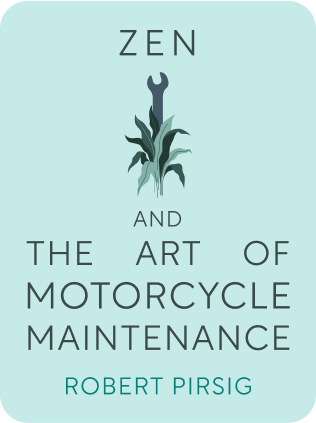

This article is an excerpt from the Shortform book guide to "Zen And The Art Of Motorcycle Maintenance" by Robert Pirsig. Shortform has the world's best summaries and analyses of books you should be reading.
Like this article? Sign up for a free trial here .
What are the Zen and the Art of Motorcycle Maintenance themes? How are these themes conveyed?
There are several important Zen and the Art of Motorcycle Maintenance themes. They include technology, a good quality of life, and treating life like a journey.
Read more about the Zen and the Art of Motorcycle Maintenance themes.
4 Important Zen and the Art of Motorcycle Maintenance Themes
What are the most important Zen and the Art of Motorcycle Maintenance themes? How are these themes expressed through the chautauquas?
There are four major themes in Zen and the Art of Motorcycle Maintenance. Author Robert Pirsig explains each of the themes through his chautauquas. Read more about the Zen and the Art of Motorcycle Maintenance themes below.
Modern Technology and the Human Response
Pirsig’s discourses on technology are a response to the “Beat” and “Hippie” cultural movements, which equated “technology”—machinery, engineering, physical science—with either soulless consumption or catastrophic innovations like the hydrogen bomb. Drawing on Phaedrus’s thought, Pirsig divides humanity into two kinds of thinkers:
- Classical thinkers, who assess objects in the world in terms of their functions; and
- Romantic thinkers, who assess objects in the world in terms of their appearance.
John Sutherland is Pirsig’s prime example of a romantic thinker. Sutherland refuses to learn how to maintain his motorcycle because it’s “square”—it smacks of cold, procedural knowledge that runs counter to the “grooviness” and spontaneous creativity he prizes. Pirsig, meanwhile, a self-anointed classical thinker, relishes knowing how his motorcycle functions and being able to repair it if something goes wrong. This is one of the Zen and the Art of Motorcycle Maintenance themes that comes up throughout the book.
Quality
The central theme of the second half of ZAMM, “Quality” was Phaedrus’s intellectual obsession and constitutes the origin of Pirsig’s musings on the classical/romantic divide.
Quality is…hard to define, especially given the fact that Phaedrus makes clear that to define Quality is to misunderstand it.
Pirsig devotes dozens of pages to narrating Phaedrus’s explorations of Quality. Because Quality touches all aspects of human experience, from the metaphysical to the mundane, Pirsig is able use Quality as a springboard to discuss almost anything. Over the course of 200+ pages, Pirsig covers Montana state politics, the academic discipline of rhetoric, Eastern philosophy, 19th-century mathematics, and ancient Greek philosophy, among other topics.
But it’s when Pirsig turns to the practical task of repairing a motorcycle that the power of Quality-thinking becomes clear. Essentially, to be attuned to Quality, we must cultivate a “beginner’s mindset”—we must forget what we know (or think we know) and simply meditate on the task in front of us. This is why it’s Pirsig’s firm belief that to be “stuck”—on a work or creative project, on making a life decision—is actually, counter-intuitively, the best place to be. It’s at that moment, when our go-to intellectual or emotional strategies fail us, that we begin to hook into Quality, the metaphysical something that will always lead us to a solution.
Gumptionology 101
In the final 100 pages of the book, Pirsig spends about 25 talking about gumption—which, in the ZAMM context, we can think of as “enthusiasm for the task at hand.”
Say you notice a loose doorknob. You’ve fixed doorknobs in the past, and you know exactly how to fix this one—in fact, you’re already imagining the satisfaction of getting down to work on that doorknob and repairing it without breaking a sweat. At this moment, you’re filled with gumption.
But then let’s say you can’t find the right tool—the tool you imagined wielding so skillfully—and you realize you won’t be able to fix the doorknob. Suddenly all that gumption goes up in smoke. You’ve hit a gumption trap.
Pirsig believes gumption to be both effect and promoter of Quality-thinking. If you’ve gotten stuck on a project or task, and overcome that stuckness by dint of your “beginner’s mindset,” you’re going to be brimming with gumption the next time you get stuck. And that gumption will lead you again to find novel solutions and innovative ideas (i.e., Quality).
Although Pirsig’s long list of gumption traps and workarounds is largely motorcycle-specific, there is one group of traps—“hang-ups,” or internal gumption traps—that can hamper any effort. Among these hang-ups are traits like ego (which prevents us from acknowledging stuckness and opening ourselves to Quality) and impatience (which causes us to rush into a non-Quality solution just to get something done). Pirsig’s descriptions of and recommendations for these gumption traps can be found in Chapter 9 of the full summary.
The Journey Is the Prize
Throughout the book, in both the Chautauquas and the narrative, Pirsig suggests that his and Chris’s road trip isn’t about arriving at any particular destination—rather, it’s about the traveling itself. All too often we become consumed with ends—a job, a promotion, a purchase—and forget to appreciate the means by which we arrive at those ends.
Now that you know about the Zen and the Art of Motorcycle Maintenance themes, you can consider them as a part of your reading of the book and think about how to incorporate these lessons and philosophies into your life.

———End of Preview———
Like what you just read? Read the rest of the world's best book summary and analysis of Robert Pirsig's "Zen And The Art Of Motorcycle Maintenance" at Shortform .
Here's what you'll find in our full Zen And The Art Of Motorcycle Maintenance summary :
- How an unnamed narrator and his son are on a cross-country motorcycle journey
- Why technology can be creative
- How to focus on what's in front of you in order to get exactly what you need






